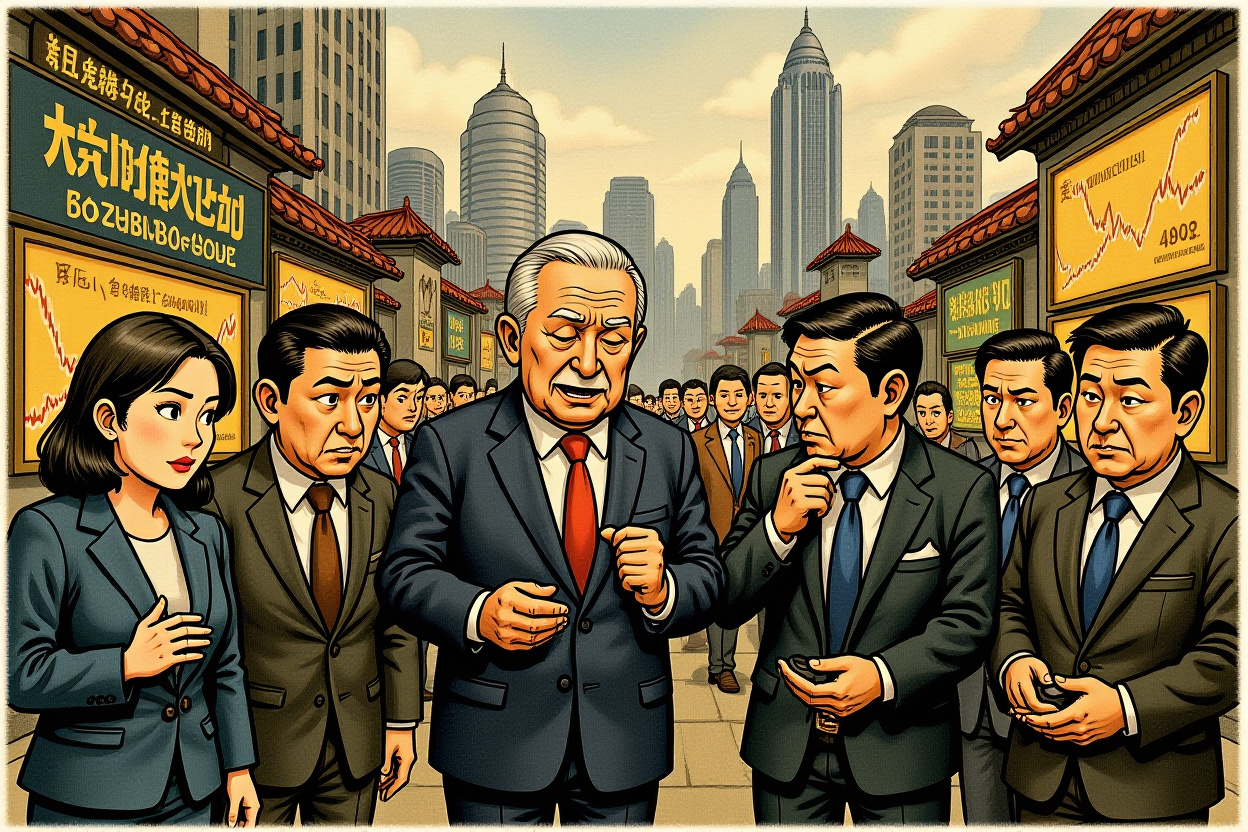Shanghai Construction Group (上海建工) experienced one of the most dramatic trading sessions in recent Chinese market history on September 19th, when the stock opened strong then plummeted to hit the daily limit down within minutes. This ‘heaven and earth board’ phenomenon – where a stock hits both the upper and lower trading limits in a single session – capped a week of extraordinary volatility that captured market attention nationwide and highlighted the speculative nature of certain Chinese equity movements. After five consecutive days of hitting the 10% upper trading limit, Shanghai Construction Group opened on September 19th with continued momentum before abruptly reversing course. Within just two minutes of morning trading, the stock plunged to hit the 3.49 yuan per share limit down price, completely erasing the previous day’s gains and then some. This violent reversal came after the stock had reached 3.88 yuan per share on September 18th – its highest price point in nearly a decade. Amid the market frenzy, the human story of an 82-year-old retail investor captured public imagination. Known affectionately as ‘Uncle Zhou’ or ‘Construction Uncle’ among traders at Shanghai’s Guangdong Road outdoor stock discussion group, this longtime shareholder had held Shanghai Construction Group through a decade of disappointment before finally seeing breakeven. According to detailed reporting by First Financial (第一财经), Uncle Zhou initially invested 500,000 yuan in Shanghai Construction Group back in 2013 when the stock traded around 6 yuan per share. Although the shares briefly surged to 17 yuan during the 2015 market boom, he held through the peak. As the stock subsequently declined – eventually hitting a low of 1.84 yuan per share in September 2024 – his retirement savings dwindled dramatically. The persistent investor employed a dollar-cost averaging strategy, using monthly pension payments and occasional bonus income to continuously add to his position throughout the decade. His relentless averaging brought his cost basis down from approximately 6 yuan to around 3.8 yuan per share, setting the stage for potential breakeven if the stock could recover. Social media videos showed the plainly dressed elderly investor regularly consulting with fellow traders at Shanghai’s informal ‘street stock salon,’ where market participants offered advice on trading strategies and company developments. The community provided both practical guidance and emotional support during the long years of underwater investing. On September 18th, as Shanghai Construction Group hit its multi-year high, fellow traders celebrated with Uncle Zhou as his portfolio finally showed breakeven after a decade of patience. The celebration proved tragically short-lived when the following day’s trading session wiped out all those gains. The dramatic price movement stemmed from renewed market excitement about Shanghai Construction Group’s gold mining subsidiary, Zala Mining. Market rumors suggested the company’s Koka gold mine had increased reserves by 338,900 ounces – approximately 4.27 billion yuan worth of gold at current prices. Shanghai Construction Group was forced to issue four consecutive days of ‘stock trading abnormal fluctuation announcements’ from September 15th-18th, clarifying that the gold reserve information was actually previously disclosed material rather than new developments. The company specifically noted that gold-related business contributes minimally to overall operations. According to corporate disclosures, gold business revenue represented less than 0.5% of total company revenue between 2019 and the first half of 2025, with sales ranging between 400 million and 1.06 billion yuan annually. The company originally acquired its 60% stake in Zala Mining back in May 2012, with initial estimates of 760,000 ounces of gold reserves at the Koka mine. The recent market excitement actually concerned additional reserves that were first announced in 2020, though the company noted in July 2024 that exploration had covered less than 10% of the total area, suggesting potential for further discoveries. Beneath the gold mining excitement lies the fundamental reality of Shanghai Construction Group’s actual business model. The company remains primarily a construction enterprise with struggling core operations in the current economic environment. Shanghai Construction Group is a state-owned enterprise specializing in construction, with an impressive portfolio that includes iconic projects like Shanghai Tower, Guangzhou Tower, Jin Mao Tower, and Shanghai World Financial Center. The company has expanded into urban renewal, water conservation, ecological environment, industrial construction, construction services, and new infrastructure sectors. The company maintains significant international operations across Asia, Africa, Latin America, the Caribbean, North America, and Europe, with hundreds of overseas projects including the Mekong River Bridge and Cambodian National Highway. It also maintains real estate development operations through its ‘Haiyue’ premium residential projects in Shanghai, Nanjing, Suzhou, and Tianjin. The company’s mid-year financial results, announced in August, revealed significant challenges: Revenue of 105.042 billion yuan, down 28.04% year-over-year; Total profit of 1.084 billion yuan, declining 23.2% annually; Net profit attributable to shareholders of just 710 million yuan, down 14.07%; Net profit after extraordinary items plummeted 69.13% to 217 million yuan; Total assets decreased 7.62% to 357.404 billion yuan. These numbers continue a troubling trend that began in 2022, with annual revenue growth falling below 7% before turning negative last year. Profitability has been declining since 2022, with only a brief respite in 2023 before resuming downward momentum in 2024. The Shanghai Construction Group saga offers several important lessons for investors in Chinese equities, particularly regarding speculative rallies based on peripheral business activities. The dramatic disconnect between the gold mining narrative and the construction reality highlights how quickly markets can become captivated by compelling stories rather than fundamental financials. Despite gold mining representing less than 0.5% of revenue, it temporarily drove the company’s market valuation based on speculation about future potential rather than current contribution. This phenomenon is particularly pronounced in markets where retail investors comprise a significant portion of trading activity. The emotional appeal of a ‘gold discovery’ story can overwhelm rational analysis of actual business fundamentals. While retail investors chased the gold narrative, institutional investors likely recognized the minimal impact of mining operations on overall financials. The extreme volatility created opportunities for sophisticated traders to profit from the mispricing, while less experienced investors risked significant losses. The case illustrates why professional investors conduct thorough due diligence on revenue contribution percentages rather than chasing exciting narratives about minor business segments. The Shanghai Construction Group story continues to unfold, with several key developments worth monitoring for investors considering Chinese construction and infrastructure stocks. The extreme volatility may attract regulatory attention from the China Securities Regulatory Commission (CSRC 中国证监会), particularly if evidence emerges of coordinated manipulation or misinformation campaigns. Chinese authorities have increasingly focused on market stability and protecting retail investors from excessive speculation. Companies themselves face pressure to more clearly communicate material information to prevent misinterpretation or manipulation. Shanghai Construction Group’s repeated announcements attempting to clarify the gold reserve situation demonstrate this responsibility. The事件 highlights challenges facing China’s entire construction sector amid property market adjustments and economic transition. Companies are seeking diversification opportunities, but investors must carefully evaluate whether new ventures represent meaningful diversification or merely narrative creation. The substantial difference in profitability between construction (7.37% gross margin) and mining (26.74% gross margin) explains why companies and investors alike are attracted to resource businesses, but the minimal revenue contribution means these activities cannot offset core business challenges in the near term. The Shanghai Construction Group volatility offers valuable lessons for investors navigating Chinese equity markets: Always verify the actual revenue contribution of business segments driving market narratives; Recognize that extreme volatility often creates both opportunities and risks depending on investment timeframe and strategy; Understand that emotional human interest stories, while compelling, should not drive investment decisions; Remember that state-owned enterprises may have different priorities and constraints than privately-owned companies; Consider how regulatory developments might impact highly speculative trading activity. For Uncle Zhou and countless other retail investors, the事件 serves as a reminder that breakeven after a decade of patience represents recovery of capital but not recovery of lost opportunity cost. The psychological relief of escaping a losing position must be balanced against the reality that those funds were tied up for years without meaningful return. As Chinese markets continue developing and maturing, both companies and investors must increasingly focus on sustainable value creation rather than speculative narratives. The construction sector faces genuine challenges requiring fundamental solutions rather than temporary market excitement about peripheral activities. Professional investors should continue monitoring Shanghai Construction Group’s core business performance while recognizing that mining operations remain insignificant to overall financials for the foreseeable future. The company’s success will ultimately depend on navigating construction sector headwinds rather than capitalizing on gold price fluctuations.
Shanghai Construction Group’s Dramatic ‘Heaven and Earth Board’ Volatility: Gold Mine Hype Meets Construction Reality




